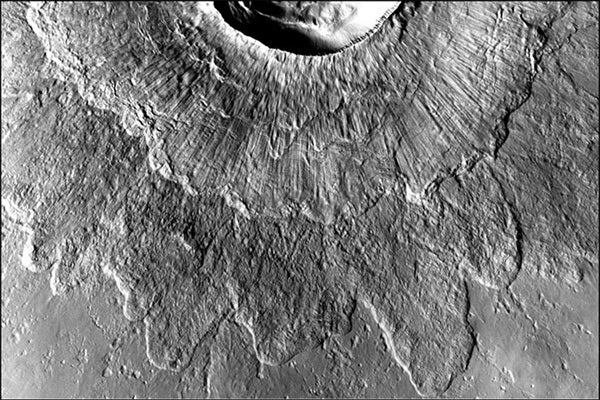Double-layered ejecta craters (DLEs), like other craters, are surrounded by debris excavated by an impactor. What makes DLEs different is that the debris forms two distinct layers — a large outer layer with a smaller inner layer sitting on top. These distinctive craters were first documented in data returned from the Viking missions to Mars in the 1970s, and scientists have been trying ever since to figure out how the double-layer pattern forms.
A new study by David Kutai Weiss and James W. Head from Brown University in Providence Rhode Island suggests that DLEs are the result of impacts onto a surface that was covered by a layer of glacial ice tens of meters thick.
“Recent discoveries by planetary geoscientists at Brown and elsewhere have shown that the climate of Mars has varied in the past,” Head said. “During these times, ice from the polar caps is redistributed into the mid-latitudes of Mars as a layer about 50 meters [164 feet] thick, in the same place that we see that the DLEs have formed. This made us think that this ice layer could be part of the explanation for the formation of the unusual DLE second layer.”
In the scenario Weiss and Head lay out, the impact blasts through the ice layer, spitting rock and other ejecta out onto the surrounding ice. But because that ejected material sits on slippery ice, it doesn’t all stay put. Weiss and Head believe the layering occurs when material near the top of an upraised crater rim slides down the slippery ice and overtops material on the lower slopes. That landslide, enabled by steep slopes and a slick ice layer, creates the DLEs’ telltale two-layered appearance.
“I think for the first time since DLEs were discovered in the 1970s we have a model for their formation that appears to be consistent with a very wide range of known data,” Weiss said. An understanding of how these and other crater types formed could help researchers reconstruct the environmental conditions at the time of the impacts.
A good fit to the data
The landslide scenario explains several of the distinct features of DLEs. Most directly, it explains radial striations — grooves radiating out from the crater rim — that are common on the inner ejecta layer of DLEs. Striations are common in landslides on Earth, Weiss said, “especially landslides on glaciers.”
That got Weiss and Head thinking that ice could be a key ingredient for making a DLE. Ice would reduce the coefficient of friction on the slopes of crater rims, increasing the likelihood of a slide. “When I did a quick calculation, I realized that the landslide wouldn’t be expected to happen [on crater rims] unless the ejecta was landsliding on an ice layer,” Weiss said.
The scenario also requires a steep slope on the outside of a crater rim. A raised rim is partly a function of crater size, with larger craters generally having less uplift. Weiss calculated that craters larger than about 16 miles (25 kilometers) probably wouldn’t have steep enough rims to cause an icy landslide. With those results in hand, he surveyed about 600 known DLEs and found that nearly all of them are between 0.6 and 16 miles (1 and 25km) in diameter.
The ice model also accounts for other distinctive features of DLEs. For example, unlike other crater types, DLEs tend not to have secondary craters surrounding them. Secondary craters are the result of big chunks of ejecta blasted out of the main crater, leaving gouges in the surrounding surface when they land. But if that surrounding surface were covered by ice, evidence of shallow secondary craters would disappear when the ice disappeared.
The model also appears to explain the locations of DLEs at middle or high latitudes — areas where scientists believe there may once have been glacial ice on Mars.
Ultimately, understanding how DLEs and other crater types are formed could lead to a better understanding of Mars’ past.
“There are over 600 DLEs on the martian surface, so reconciling how they formed with our knowledge of the climate of Mars is pretty important,” Weiss said. “It could tell us a lot about the history of the martian climate on a global scale.”










